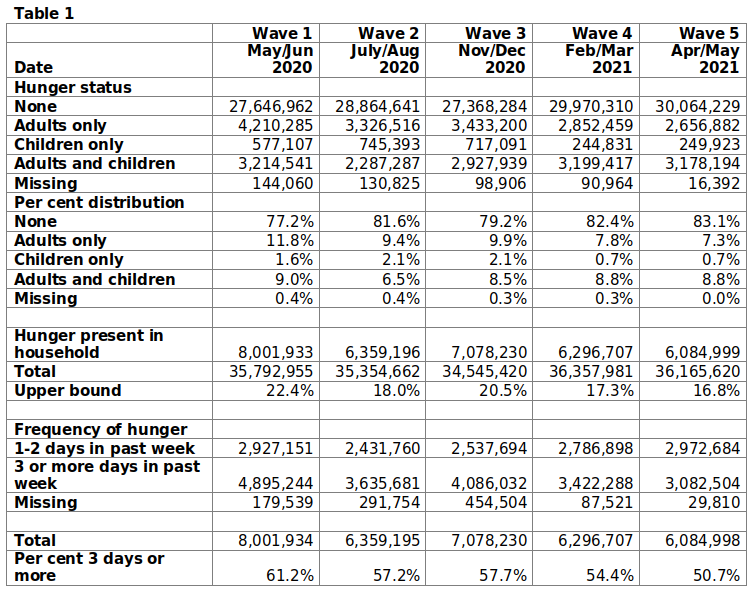Do We Have an Adequate Measure of Hunger in South Africa? II - The National Income Dynamics Study - Coronavirus Rapid Mobile Survey
Introduction
The relief of hunger is often cited as a reason for the introduction of the social relief of distress grant. What do we know about the extent of hunger? How complete and coherent is the available information?
There are two national surveys which collect data on hunger:
- The General Household Survey, conducted once a year. The most recent year for which data have been published is 2019. Release of the 2020 GHS is scheduled for 28 October 2021.
- The five waves of the National Income Dynamics Study’s Coronavirus Rapid Mobile Survey covering five of the months between April 2020 and March 2021.
The previous brief in this series discussed the 2019 GHS. The NIDS-CRAM results are considered in this brief.
The NIDS-CRAM survey
The National Income Dynamics Study, a household panel study implemented in the School of Economics at the University of Cape Town, has carried out five longitudinal studies between 2008 and 2017. Using a subsample from the fifth study, NIDS-CRAM has conducted a further five studies, referred to as waves, on the impact of the coronavirus epidemic. The reference months for the waves were April 2020, June 2020, October 2020, January 2021 and March 2021. In each wave, five questions were asked about hunger:
- Whether the household ran out of money to buy food in the reference month
- Whether anyone in the household had gone hungry because there wasn’t enough food in the seven days before the interview
- If the answer to question 2 was affirmative, how often they went hungry
- Whether any child in the household had gone hungry because there wasn’t enough food in the seven days before the interview
- If the answer to question 2 was affirmative, how often they went hungry
The questions, and possible responses, are set out in the Annexure.
Unlike the GHS, there are no questions dealing with the preceding 12 months. The focus is on recent past hunger, rather than on food security more generally. On the other hand, NIDS-CRAM measures hunger over a week, and its frequency. The only question that the GHS and NIDS-CRAM have in common is the one about running out of food during a recent month and even that does not take exactly the same form. The two data sets are complementary: the question is whether they are compatible.
A note on interpretation
The GHS is a representative sample of households with each person recorded within the selected households. NIDS-CRAM is a representative sample of individuals rather than households, making household level analysis impossible. However, it is possible to estimate statistics at an individual level about household living conditions. As the NIDS-CRAM Panel User Manual puts it:
It would be legitimate to state “For a broadly representative sample of adults from 2017, who were re-interviewed in 2020, we estimate that X% of adults live in households receiving a government grant”. However, it is not legitimate to estimate that Y% of households received a government grant. In the same way one could say that Z% of adults live in households where children went hungry, but not that A% of households had children going hungry or that B% of children went hungry.[1]
Accordingly, neither the number of households with hungry members nor the number of hungry people can be estimated from the NIDS-CRAM data. What can be done is to estimate upper bounds on the number of hungry adults by using the same procedure as in the previous brief and assuming that if one person is hungry in a household is hungry, everyone is. This would mean that if the respondent reported that someone in their household was hungry, the respondent was too. This will often be the case, but not always, so the estimate is an upper bound. If no-one in the household was hunger, the respondent couldn’t have been hungry either. This procedure cannot be used for children, since there were no child respondents[2].
Findings
Table 1 presents estimates of the distribution of households by hunger status based on information supplied by adult respondents in waves 1 to 5. Thus, 77.1% of adults lived in households with no reported hunger in wave 1, 9.4% of adults lived in households with reported hunger only among adults in wave2, and so on. This enables upper bound estimation of the number of adults who were hungry in each of the waves.
A household frequency of hunger measure can be constructed by taking the greater of reported frequency of hunger among adults and among children (if any). Hunger frequency is regarded as moderate if a household experienced hunger in one or two days per week and severe if it experienced hunger for three days or more. Adults who lived in a household with severe hunger are reported as a percentage of adults who lived in households with any hunger.
Two important points emerge from Table 1. The first is that the upper bound estimates of hungry adults, as a percentage of all adults, are considerably higher than the upper bound estimates derived from the 2019 GHS as reported in the previous brief. The second is that with the exception of a blip in wave 3, the trend in the upper bound has declined across the waves. The same movement is found when the intensity of hunger, as measured by the number of days in the week that hunger was reported, is considered. A contextualization of these trends will be presented in a later brief.
Table 2 sets out the distribution of adults according to whether their households ran out of money to buy food in a reference month. The pattern observed is the same as in Table 1. One might suppose that running out of money to buy food would entail hunger, but it appears from both the GHS and NIDS-CRAM that this is not always the case. This suggests that some respondents are interpreting the situation by saying that the household could not have spent more money on food than it did, while the food purchased was sufficient not to report hunger.


Conclusions
- To most people, hunger means, in the first instance, lack of satiety, and the responses to the limited questions in the NIDS-CRAM surveys should be interpreted in that light. GHS questions about healthy and nutritious foods and diversity of foods go beyond this narrow focus, widening the perspective from hunger to food security.
- Measures of hunger and food security depend on the time frame of questions and the particulars of information asked for. Were recall perfect, hunger measures would rise as the time frame increases. Imperfect recall means that responses to questions about hunger over a long period, such as a year, will be more unreliable than responses to questions about a shorter period in the immediate past.
- The GHS shows that responses to questions are not always coherent, and that attention needs to be given to how to deal with emerging contradictions from responses.
- Understanding of the nexus between nutrition, health and physical development in South Africa is hampered by lack of the relevant information. In the light of inadequate information on diets, a survey study in 2015[3] recommended a national nutrition monitoring system in order to identify dietary deficiencies in specific population groups. And, while many studies over several decades have measured the extent of stunting, wasting and underweight among South African children, most have gone little further than explaining it by generalized references to under-nutrition and malnutrition.
- At present, there is considerable interest in cash grants as a means of reducing hunger. The GHS and, to a lesser extent, NIDS-CRAM offer information which sheds light on the possible impact of such grants. The next brief will consider it.
Charles Simkins
Head of Research
[1] Kim Ingle, Timothy Brophy and Reza Daniels, Panel User Manual, NIDS-CRAM Document Wave 3 C1, 17 February 2021
[2] The approach here can be compared with that in Servaas van der Berg, Leila Patel and Grace Bridgman, (1) Hunger in South Africa during 2020: Results from NIDS-CRAM Wave 3, NIDS-CRAM Wave 3 10, 17 February 2021 and (2) Food insecurity in South Africa: Evidence from NIDS-CRAM Wave 5, NIDS-CRAM Document Wave 5 13, 8 July 2021
[3]Zandile J Mchiza et al, A Review of Dietary Surveys in the Adult South African Population from 2000 to 2015, Nutrients 7(9), September 2015

